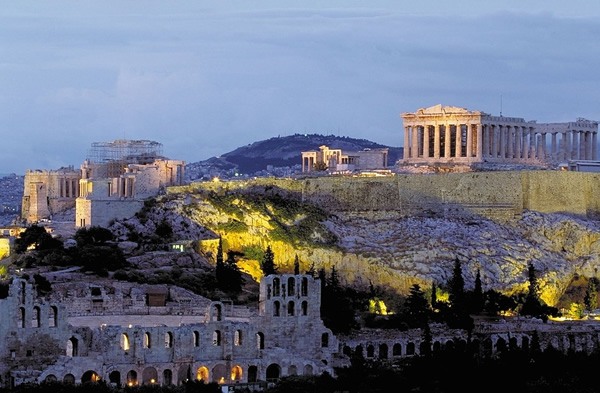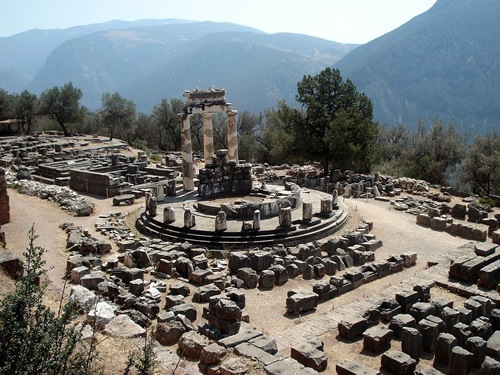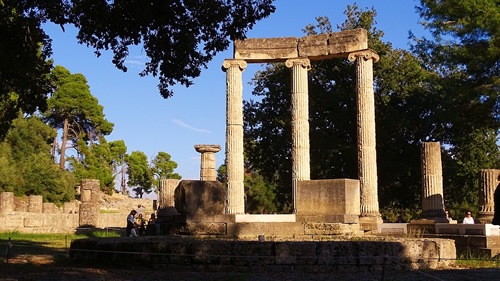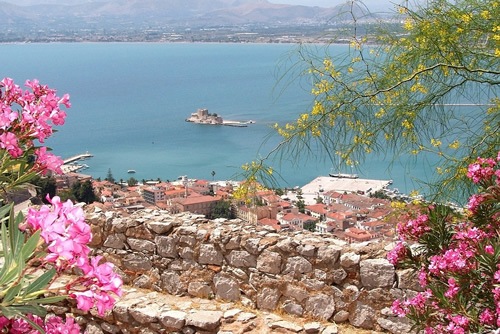A Guide to Exploring Ancient Greece and the Hellenic Past
Don't Miss the Panhellenic Circuit where the Olympics Were Born
By Drew Colenbrander

|
|
A view of the Parthenon in Athens, a city that hosted the 2004 Olympic games.
|
By visiting the sites of the original Olympics, an independent traveler can see spectacular ruins and museums, and in the process experience a Greece of stunning natural beauty and rich culture. The two natural starting points are Athens and Patras.
The Greek government’s hosting of a successful Olympics has produced great benefits for travelers. The main access road to the Acropolis, once clogged with traffic and parked tour buses, is now a pedestrian walkway. Museums and major historical sites throughout the city have been refurbished. At no time have so many ancient ruins been opened to the public, and the new subway makes them easy to reach.
If possible, visit Greece in fall or spring, when the weather is mild, the famous smog of Athens is diminished, and tourist-weary Greeks will be happier to see you.
You could visit all of the sites of the ancient Panhellenic Games on a week-long trip, though longer would be better for exploring more of mainland Greece. I recommend spending at least one night at or near each of the sites. Delphi and Olympia, in particular, attract large tour groups during the day, but both are peaceful in morning and evening.
The circuit can be traveled easily by rental car or public transportation. My wife Sarah and I used both bus and train on two visits and rented a car for a longer camping trip.
The car, which we picked up in Patras and dropped off at the Athens Airport, costs about $40 per day, plus another $100 in gas on a 3-week trip, but camping balanced out our budget. The car also enabled us to get off the main routes, hike some fantastic trails, and see much more of Greece off the tourist track.
Trains, which connect most cities, are slower and much less frequent than buses, which travel virtually everywhere. All of the locations listed on this route are accessible by bus.
Delphi

|
|
A view of sacred Dephi.
|
Three hours north from Athens, Delphi is known for its ancient oracle and temple to Apollo. Most structures associated with the Delphic Games have disappeared, but the existing stadium, along with Delphi’s other attractions, make it a compelling stop. Relatively few visitors hike the steep trail all the way to the stadium, and its setting in a pine grove adds to the tranquil atmosphere.
The structure that you see is from the Roman era. Here, as at all the sites, the Romans continued the games and expanded the existing facilities. You can sit in the remains of the stone bleachers that held over 6,000 people and understand why the Greeks placed such emphasis on the natural setting of their most important structures. Both the immediate surroundings and the views from Delphi are stunning.
Delphi itself sits on the forested slopes of Mt. Parnassos — really a range of mountains rather than a single peak. Trails lead up the slopes directly from the town; one switchback closely overlooks the stadium.
Relatively inexpensive hotels are easy to find in Delphi but we prefer the accommodations at nearby Apollon Camping, where tentsites are terraced above the “sea of olives” that reaches from the lower slopes of Parnassos to the Gulf of Corinth.
Olympia

|
|
A temple in Olympia is one of many, many remants of the ancient Olympic games.
|
Like Delphi, Olympia lies in a beautiful natural setting — the rolling forested hills and streams of Arcadia, a lush region of Greece that is a stark contrast to the bare, rocky land that most visitors see.
The most famous of Greek Olympic sites since the first recorded games there in 776 B.C., Olympia deserves at least a couple of days. Start with the archaeological museum next to the ruins. The newly restored exhibits will help you to better understand the Olympic structures and of the ancient culture associated with the games.
Start your tour through the site early in the morning before the crowds arrive. You get a sense of the huge scale of the ancient games as you wander through the remains of buildings and temples where athletes trained, visitors lodged, and everyone worshiped. The largest temple, dedicated to Zeus, the patron god of the games, contained a gold and ivory statue by the master sculptor Phidias, remembered as one of the seven wonders of the ancient world.
Enter the huge stadium and stroll the archway and tunnel through which athletes entered for the competitions. Wandering around the site you will make discoveries not marked on most maps and guidebooks.
The small modern town of Olympia is filled with facilities for travelers on any budget. The new Olympic Palace Hotel is a good value for its posh atmosphere and location. There is also a campground, with views over the valley, a few minutes walk from the town.
Untrammeled Greece can be found in nearby villages. Within a half-hour drive of Olympia we have enjoyed marvelous homestyle meals in local tavernas that rarely see tourists.
Nafplio, Nemea, and Isthmia

|
|
Nafplio, in the Peloponnese Peninsula, is a great base for exploration of many fascinating ruins and other natural sites.
|
Nafplio, in the southeastern corner of the Peloponnesian Peninsula, makes an ideal base camp for reaching the other Panhellenic sites of Nemea and Isthmia. Travelers and locals mingle in this town of red-tiled roofs and castle ruins. A terrific place for a traditional meal of mezes (Greek appetizers) is the O Noulis Ouzeria, where you will get a warm welcome from the owners and the regular customers.
While in Nafplio, visit the amazingly intact ancient theater at Epidaurus and the citadel of Mycenae. But on this Olympic tour save at least a day for Nemea.
This fantastic site, excavated by archaeologists from the Univ. of California Berkeley since 1973, may be the most overlooked ancient ruin in Greece. There is a superbly designed museum, a host of ruins in the process of excavation, and a magnificent stadium, all of which you will share with a few other visitors.
Bring food, for there are virtually no services in the village of Nemea. You can picnic on what is probably the only shady lawn within 200 miles. The care with which ancient Nemea is maintained is due to the extraordinary support provided by the University and other American contributors.
Make certain to see the stadium, located about half a mile from the main site. Be sure to purchase the inexpensive walking guide. It will help take you back into the past and make you feel the games come alive.
If you are pressed for time, the site of the Isthmian games near Corinth could be part of your drive to or from Athens. Though the least developed of the four sites, Isthmia has some distinctive features: a set of starting gates for sprints, the mosaic floor of a Roman bath, and a small museum displaying victory monuments and the wreaths won by winners of athletic events.
DREW COLENBRANDER teaches English at Delta College in Michigan. With his wife Sarah, he has traveled and led group trips throughout much of Greece. He has written for a variety of travel publications including Transitions Abroad.
| Related Topics |
|
Budget Travel
|
|
More from Drew Colenbrander
|
|
Affordable Italy
|
|
